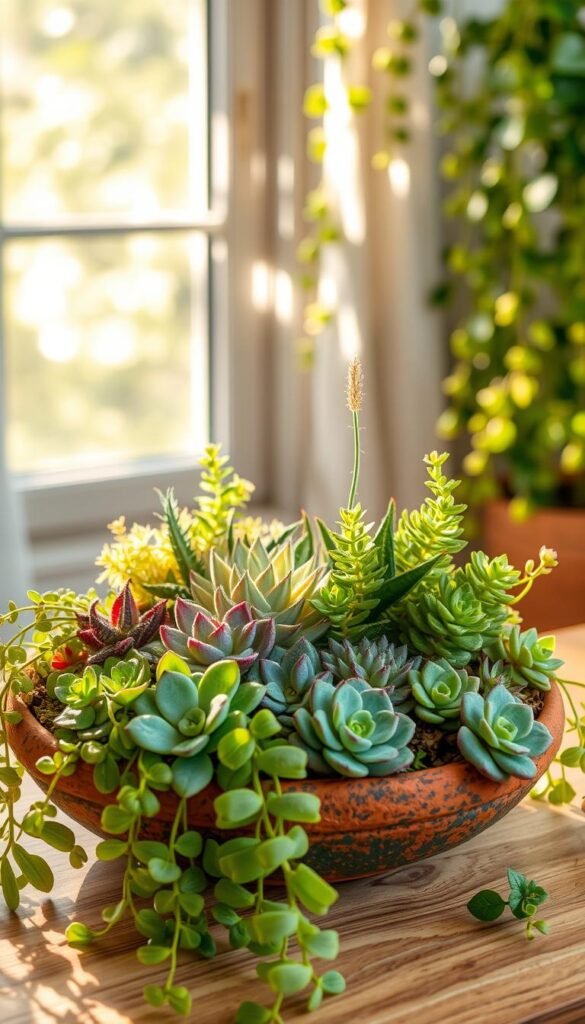Ever dreamed of turning cramped corners into lush, eye-catching displays? Miniature green arrangements let you craft vibrant ecosystems in shallow containers, blending practicality with creativity. Whether you’re working with a sunny windowsill or a dim office nook, these living art pieces adapt to your space while adding a breath of fresh air.
Start by choosing plants that thrive together. Succulents like echeveria pair beautifully with drought-tolerant sedum, while herbs like thyme and oregano create aromatic kitchen companions. The secret? Match species with similar light and water needs to ensure your creation stays healthy with minimal effort.
Texture and color play starring roles here. Mix spiky haworthia with trailing string-of-pearls for contrast, or combine burgundy-toned tradescantia with bright green fittonia. Add personality using pebbles, moss, or tiny figurines – these details turn simple pots into storytelling centerpieces.
Ready to dive in? You’ll soon discover how easy it is to design living decor that grows alongside your style. Let’s explore combinations that work as hard as they look – no green thumb required!
Understanding the Charm of Dish Gardens
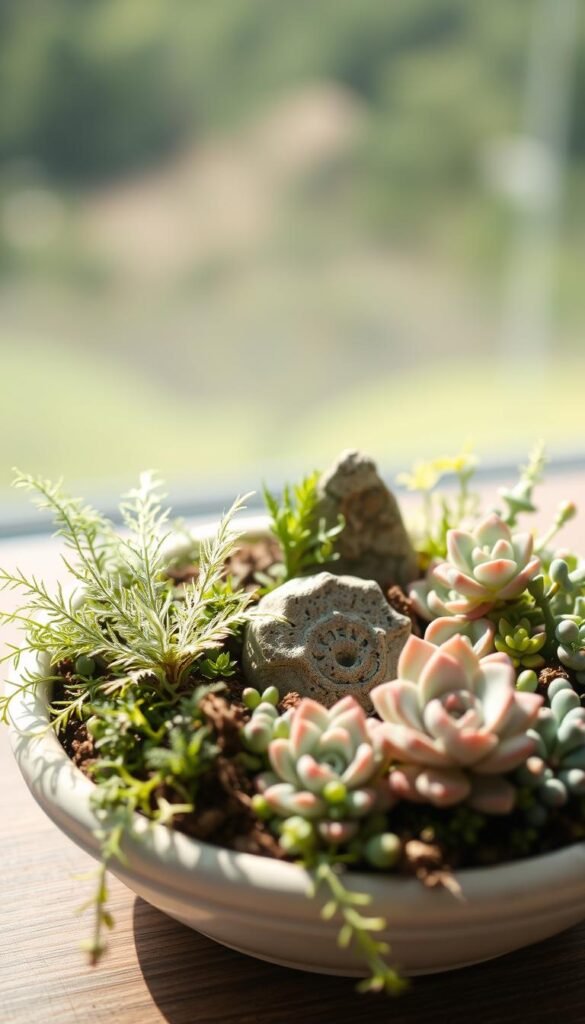
Imagine crafting a tiny living world that fits on your desk or windowsill. These compact ecosystems let you bring nature indoors while challenging your creativity. Unlike single-plant pots, they combine textures and growth habits for visual impact.
What Makes These Mini Ecosystems Work?
A successful arrangement starts with smart layering. Begin with gravel at the bottom – this keeps roots from sitting in water. Add horticultural charcoal next to fight odors and bacteria. Finish with fast-draining soil suited to your chosen greenery.
| Feature | Traditional Pots | Mini Ecosystems |
|---|---|---|
| Depth | 4+ inches | 2-3 inches |
| Watering | Weekly | Every 10-14 days |
| Design Focus | Single specimen | Group dynamics |
Building Your Foundation
Your container choice matters more than you think. Repurpose vintage trays or thrifted bowls – just ensure drainage holes or add extra gravel. Pro tip: Use chopsticks to position roots gently when planting. This prevents overcrowding as your green friends grow.
Remember, these arrangements thrive on neglect. Wait until the soil feels dry before watering lightly. Overenthusiastic care leads to soggy roots, the #1 cause of failure. Start small, and soon you’ll be mixing textures like a pro!
Exploring Creative Garden Ideas for Your Dish Garden
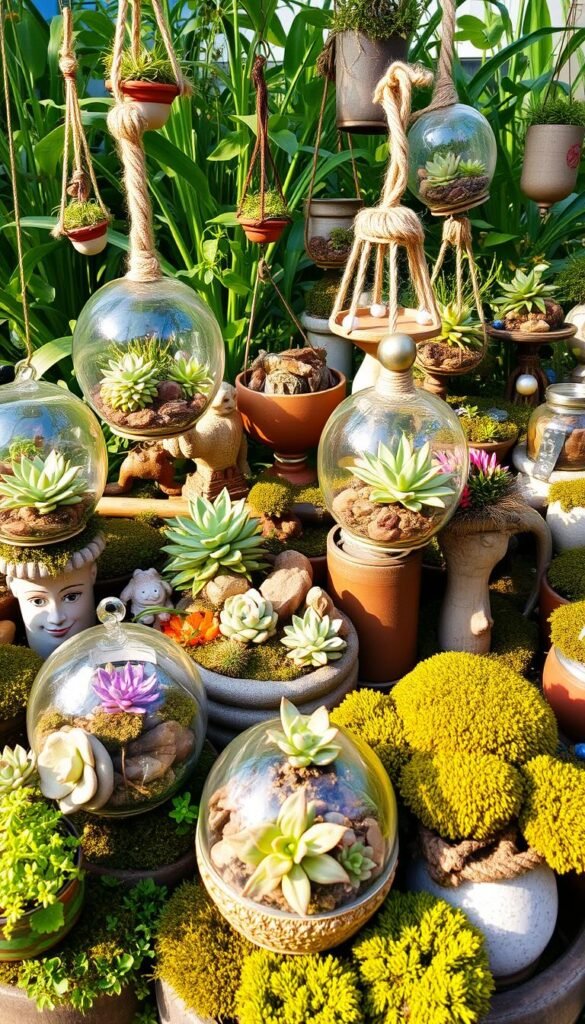
Your home becomes a canvas when you think beyond traditional pots. Transform old baking dishes into desert-scaped wonderlands or convert thrifted mason jars into hanging terrariums. Even chipped teacups find new purpose as charming homes for petite air plants.
Texture contrast makes arrangements pop. Pair rubbery peperomia leaves with feathery asparagus fern fronds. Try combining spiky aloe vera with cascading ivy – the mix of shapes keeps eyes dancing across your creation.
Add personal flair with acrylic-painted patterns on clay saucers or glue mosaic tiles to plain containers. Miniature garden gnomes or polished river stones can suggest hidden stories within your green scene. These touches turn functional planters into conversation starters.
Match greenery to your routine and space. Busy schedules pair well with drought-resistant cacti, while humid bathrooms welcome moisture-loving ferns. For dark corners, snake plants thrive while purifying air – no sunny windowsill required.
Themed displays let your imagination run wild. Craft a beachy vibe using sand, driftwood, and blue sedum as “water.” Build a mystical woodland with moss carpets and tiny fairy lights. Your living art evolves with each seasonal tweak.
Selecting the Perfect Plants: Matching Colors and Textures
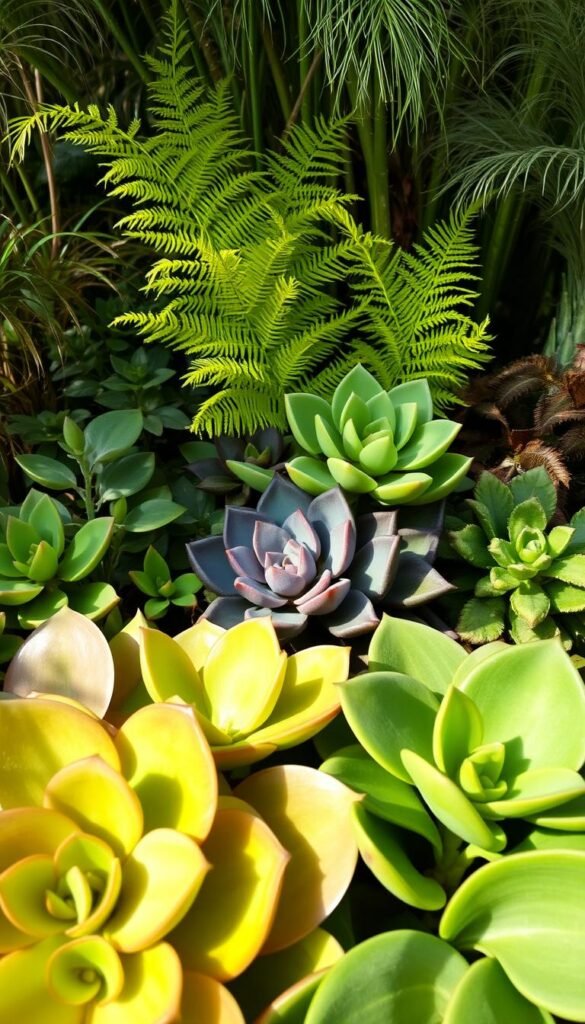
Think of your container as a painter’s palette – every choice shapes the final masterpiece. Start by choosing species that naturally enhance each other’s best features through strategic color relationships and tactile contrasts.
Complementary Plant Pairings
Monochromatic schemes create sophistication. Try silver-dollar jade paired with blue chalk sticks – their matching cool tones let unique leaf shapes shine. For drama, mix burgundy waffle plants with golden pothos. The secret? Use one dominant hue and two accent shades.
| Color Scheme | Plant Examples | Visual Effect |
|---|---|---|
| Monochromatic Greens | Zebra cactus, peperomia | Calming cohesion |
| Contrasting Warm/Cool | Red aglaonema, blue sedum | Dynamic energy |
| Earth Tones | Haworthia, copper spoons | Natural harmony |
Mixing Succulents, Flowers, and More
Combine spiky aloe vera with trailing string-of-buttons for movement. Soften geometric succulents using delicate lobelia blooms. When designing companion plant pairings, consider growth speed. Slow-growers like lithops stay balanced beside seasonal pansies.
Textural layering adds depth. Broad elephant bush leaves make perfect backdrops for lacy maidenhair fern. Add sparkle with frosted echeveria or glossy pilea. Remember – your container’s finish should complement, not compete. Matte pots highlight vibrant greens, while metallic finishes amplify silvery foliage.
Dish Garden Ideas Plants: 10 Perfect Pairings for Thriving Arrangements
What transforms good arrangements into showstoppers? Strategic pairings that harmonize care needs while sparking visual drama. Start by grouping species that crave the same light and water – this shared foundation keeps your creation healthy with minimal fuss.
How to Pair Plants for Maximum Impact
Balance bold textures with delicate forms. A spiky haworthia shines beside trailing string-of-pearls, while velvety purple oxalis pops against upright snake plants. These contrasts create movement and depth without clashing care routines.
| Plant Pair | Key Features | Care Needs |
|---|---|---|
| Echeveria + Sedum | Rosette shapes vs. ground cover | Full sun, weekly water |
| Peperomia + Fern | Glossy leaves + feathery fronds | Low light, moist soil |
| Crassula + Ivy | Vertical growth + cascading stems | Bright indirect light |
Always check mature sizes. Dwarf varieties like miniature jade prevent overcrowding. Leave 1-2 inches between roots for airflow. A gravel layer under soil stops waterlogging – your plants’ worst enemy.
“Contrast is the secret sauce. Pair a star player with supporting actors that highlight its best traits.”
Rotate your container weekly for even growth. Trim fast growers to maintain proportions. With these tricks, your living artwork stays vibrant year-round.
Creating a Succulent Showpiece Dish Garden
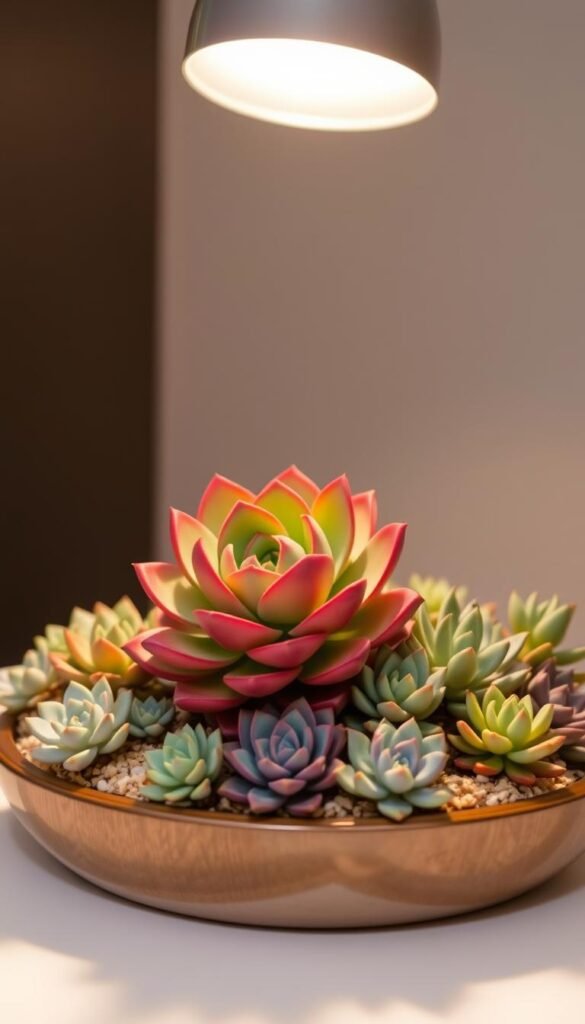
Transform your space with living sculptures that demand little but give much. These drought-resistant wonders turn shallow containers into miniature desert landscapes, blending artistry with practicality. Their varied forms – from plump rosettes to geometric spikes – create year-round visual interest.
Designing with Shape and Contrast
Start by selecting stars with complementary silhouettes. Place upright haworthia beside sprawling sedum for dynamic tension. Let trailing varieties like burro’s tail spill over edges, softening angular containers. This layered approach maximizes visual impact in limited soil depth.
| Variety | Water Needs | Light Preference | Growth Pattern |
|---|---|---|---|
| Echeveria | Low | Bright indirect | Rosette clusters |
| Haworthia | Moderate | Filtered sun | Vertical spikes |
| Sedum | Very low | Full sun | Ground cover |
Essential Care for Lasting Beauty
Use a gritty cactus mix – regular soil holds too much moisture. Water only when the top inch feels dry, typically every 18-21 days. Rotate your container weekly to prevent lopsided growth.
- Add decorative gravel between plants to reduce evaporation
- Remove dead leaves promptly to prevent rot
- Feed with diluted succulent fertilizer quarterly
“The magic happens when you treat succulents like the desert natives they are – less pampering, more observing.”
Herb-Infused Mini Gardens: Flavor and Fragrance
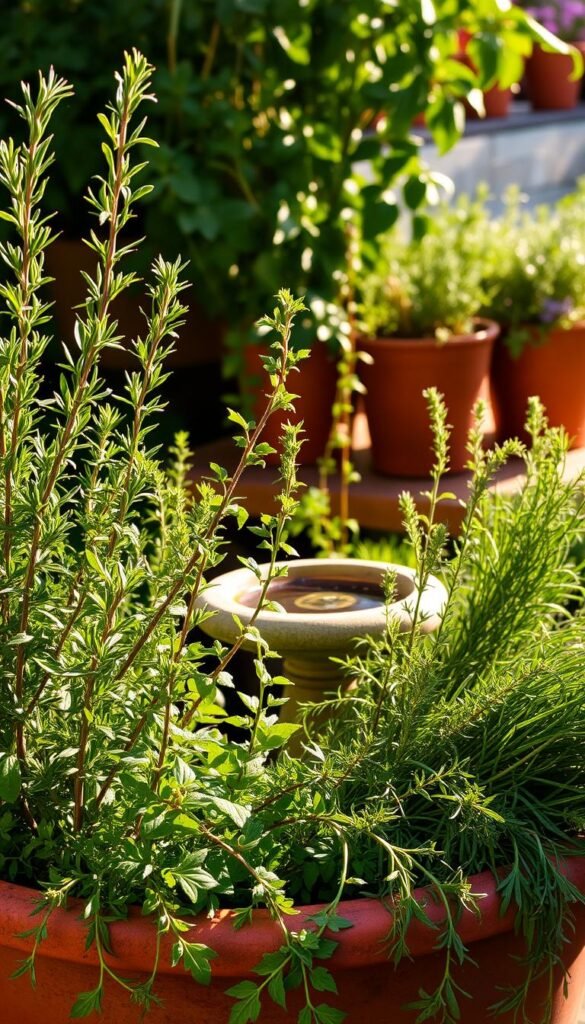
What if your cooking essentials doubled as living decor? Compact herb displays bring zest to meals while refreshing your space. These edible arrangements thrive in shallow pots near sunny windows, blending fresh scents with handy ingredients.
Choosing the Right Herbs for Your Kitchen
Select varieties that match your cooking style and space. Basil and thyme work well for Italian dishes, while mint elevates drinks and desserts. Dwarf varieties like ‘Spicy Globe’ basil stay tidy in confined setups.
| Herb | Light Needs | Growth Habit | Culinary Use |
|---|---|---|---|
| Greek Oregano | 6+ hours sun | Bushy | Pizza, sauces |
| Lemon Thyme | 4-6 hours sun | Trailing | Fish, marinades |
| Fernleaf Dill | Partial shade | Upright | Pickling, dips |
Practical Care for a Thriving Herb Garden
Rotate pots weekly for even growth. Water when the topsoil feels dry – usually every 5-7 days. Snip leaves from the top to encourage branching.
- Use ceramic pots with drainage holes
- Mix sand into potting soil for better drainage
- Feed monthly with diluted fish emulsion
Harvest sprigs before flowers appear for peak flavor. Your mini garden becomes a sensory experience – brush leaves to release aromatic oils while cooking.
Tropical Arrangements: Bringing a Lush Vibe to Your Dish Garden
Who says you need a rainforest to enjoy exotic greenery? Tropical setups turn everyday spaces into vibrant retreats using bold foliage and layered textures. These lush displays thrive in warm, humid conditions – perfect for adding life to kitchens, bathrooms, or bright living areas.
Choosing Rainforest-Ready Species
Start with ferns like bird’s nest or maidenhair for feathery texture. Add bromeliads for pops of color – their cup-shaped centers collect water naturally. Pair with orchids like phalaenopsis for elegant blooms that last months. These plants share similar needs, making care straightforward.
| Plant | Light Needs | Water Frequency |
|---|---|---|
| Staghorn Fern | Bright indirect | Weekly misting |
| Guzmania Bromeliad | Medium light | Keep center cup filled |
| Moth Orchid | Filtered sunlight | Every 7-10 days |
Crafting the Ideal Environment
Place your arrangement near east-facing windows for gentle morning sun. Use a pebble tray filled with water beneath the container to boost humidity. Group plants tightly – their combined transpiration creates a mini microclimate.
- Mist leaves every 3 days using room-temperature water
- Rotate plants weekly for even growth
- Use chunky orchid mix for quick drainage
With bright indirect light and consistent moisture, your tropical display becomes a living slice of paradise. Watch for new fern fronds unfurling or bromeliad pups forming – signs your green haven is thriving!
Vertical Dish Gardens: Maximizing Your Limited Space
What if your walls could bloom? Vertical setups turn blank surfaces into thriving green tapestries, perfect for tight corners. By growing upward instead of outward, you create living art that breathes life into narrow hallways or compact balconies.
Creative Hanging and Stacked Planter Ideas
Start with lightweight containers that won’t strain your walls. Macramé hangers cradle succulent dishes, while repurposed wooden crates stack beautifully for cascading herbs. Mix materials – try metal frames with ceramic inserts for industrial charm.
| Vertical Setup | Best Plants | Space Saved | Care Tips |
|---|---|---|---|
| Hanging Baskets | String-of-pearls, ivy | 100% floor area | Water with squeeze bottle |
| Stacked Planters | Sedum, creeping thyme | 75% footprint | Rotate weekly |
| Wall-Mounted Frames | Air plants, moss | 90% surface use | Mist every 5 days |
Trailing varieties shine in these arrangements. Pothos vines drape elegantly from shelves, while flowering colorful container plants brighten tight spaces. Secure heavy planters with toggle bolts – safety first!
Unexpected spots become prime real estate. Try a magnetic herb garden on your fridge or mount succulents above radiators (heat-tolerant types only). Your vertical oasis grows where traditional pots can’t – limited square footage becomes limitless potential.
Indoor Low-Light Greenery Options for Dish Gardens
Not every corner of your home basks in sunlight, but that doesn’t mean you can’t enjoy vibrant greenery. Resilient species like snake plants and ZZ varieties turn dim spaces into lush displays while needing minimal attention. These natural air cleaners thrive where other plants struggle, making them ideal for shelves, bathrooms, or north-facing rooms.
Best Plant Choices for Shady Areas
Pothos vines drape elegantly from containers, their heart-shaped leaves brightening tabletops. Pair them with the architectural spikes of snake plants for contrast. For compact setups, try shade-tolerant greenery like ZZ plants – their glossy foliage adds polish without demanding frequent watering.
Simple Decoration and Air-Purifying Benefits
These low-maintenance options do double duty. They filter toxins while adding texture to your indoor spaces. Cluster a few in shallow bowls with decorative pebbles for instant style. Their ability to grow in weak light means you can refresh any room’s air quality, even without sunny windows.

